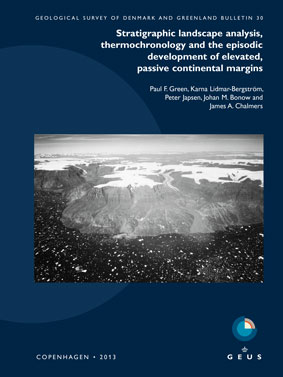In the late 19th and early 20th century, William Morris Davis popularized the concept of the peneplain, an extensive low-relief erosion surface graded to sea level. Peneplains were strongly associated with Davis’ cyclical model of landscape evolution, which fell out of favor with most geomorphologists decades ago. By association, the discussion and study of peneplains also fell out of favor.
But peneplains are making a comeback. This is best illustrated by a report from the Geological Survey of Denmark and Greenland (Green et al., 2013), though the ideas and evidence are also laid out in a number of journal articles by the various co-authors. The report is concerned with development of elevated passive continental margins (think of, e.g., the Great Escarpment of Africa, the eastern Australian highlands, or the main subject of the report, west Greenland). The arguments are strongly dependent on the identification and interpretation of planation surfaces. As these planation surfaces are low-relief, regionally extensive, and are eroded across geological materials of varying resistance, and because the authors present evidence that they were originally graded to sea-level (they were subsequently uplifted), they can be legitimately referred to as peneplains.

The report also includes a nice review and synthesis of the peneplain concept and its utility in reconstructing landscape evolution. One of the papers they cite is my 2002 paper: Erosion, isostatic response, and the missing peneplains. On the few occasions this paper is cited, it is normally, and not completely unfairly, cited as representing the anti-peneplain viewpoint. The main point of that paper, however, is to attempt an explanation as to why so few (some would argue no) examples of contemporary peneplains exist. The paper acknowledges existence of old planation surfaces that fit all definitions of peneplain other than their role in a Davisian cycle, and that the theory of peneplain formation (i.e., what would happen with long periods of denudation in the absence of substantial changes in tectonics or base level) is sound. This being the case, and with the amount of effort geomorphologists and other geologists have put into searching for peneplains, where are they? Note that this refers to peneplains graded to Quaternary sea-levels, not the elevated planation surfaces identified by Green et al. (2013) and others.
My proposed explanation was based on the dynamical instability of the interrelationships among denudation, deposition, elevation, isostatic uplift, and isostatic subsidence. This implies that no particular state of landscape evolution (peneplanation or otherwise) would persist over long periods in the face of perturbations associated with tectonics, climate, sea-level, or other factors affecting topographic evolution over long time periods and broad areas. If this is true, then: (1) There should be few, if any, examples of landscapes (such as peneplains) that require the operation of a single mode of topographic evolution over time periods longer than those at which fluctuations of climate, sea level, and tectonic activity occur. (2) Evidence should exist that changes in climate, sea level, and tectonic activity result in changes in the fundamental mode of landscape evolution rather than just fluctuations in the rates of geomorphic processes. (3) Ancient landscapes should not show evidence of (or their existence should not require) the continual existence of any particular mode or state of landscape evolution throughout their history. In the 2002 article, I tentatively accepted all three, and still stick with (1) and (2). Evidence presented by Green et al. (2013), both primary and in their review of other work, brings point (3) into serious doubt. The question is, is this because my model is wrong (nnnnooooooo . . . . .!), or because (as others have argued) the late Cenozoic has been more active than Earth’s geological norm with respect to tectonics and climate change? This could explain the presence of ancient, uplifted peneplains and the absence of geologically contemporary ones. Green et al. (2013) do, for instance, point out that 6 millon years is apparently not enough time for a peneplain-type planation surface to develop; 26 Ma being more like it.
Overall, their work is an excellent example of integrating topographic, stratigraphic, thermochronological, and age-dating evidence, and of arguments where observational evidence (rather than theoretical predispositions or prevailing orthodoxy) are paramount. It also poses some interesting challenges to the tectonic-geological orthodoxy regarding mountain building, in the tradition (in my opinion, Green et al. do not cite it) of Ollier and Pain’s The Origin of Mountains (Cambridge Univ. Press, 2000). It also shows the utility of elevated planation surfaces in reconstructing landscape evolution, regardless of how uncool it may be to call them peneplains.
Finally, a minor, maybe even trivial, quibble: Green et al. (2013) cite my 2005 paper on weathering and landscape evolution as supporting a view that base level is unimportant with respect to weathering. This is off-base (pun, as always, intended); my paper includes the statement “ . . . denudation and weathering are limited by base level . . . . “
So there.
Green, P.F., Lidmar-Bergstrom, K., Japsen, P., Bonow, J.M., Chalmers, J.A., 2013. Stratigraphic Landscape Analysis, Thermochronology, and the Episodic Development of Passive Continental Margins. Geological Survey of Denmark and Greenland Bulletin 30, 150 p. URL: http://www.geus.dk/publications/bull/nr30/index-uk.htm
